Chemistry and Crystallization Conditions of Minerals in Metasomatized Oceanic Lithosphere and Basaltic Rocks of Govorov Guyot, Magellan Seamounts, Pacific Ocean
Abstract
:1. Introduction
2. Magellan Seamounts and Govorov Guyot: Geological Setting
3. Analytical Methods
4. Results
4.1. Classification of Volcanic and Mantle Rocks
4.2. Rock-Forming Minerals
4.3. Minor Minerals, Accessories, and Glasses
4.4. Trace Element Chemistry of Ti-Amphibole and Clinopyroxene Phenocrysts
| Ti-Amphibole | Clinopyroxene | ||||||||
|---|---|---|---|---|---|---|---|---|---|
| 08D81 | 08D99-2B | 08TR02 | 08MTP03 | 08MTP03-1 | 08D96 | 08D99-2B | 08MTP03 | 08MTP03-1 | |
| Li | 3.7 | 6.3 | 5.8 | 8.6 | 7.1 | 10 | 9.8 | 9.6 | 7.4 |
| Be | 1.1 | 1.5 | 1.9 | 1.5 | 2.1 | 0.83 | 0.69 | 1.0 | 0.92 |
| Rb | 16 | 14 | 16 | 15 | 16 | 7.0 | 6.9 | 10 | 10 |
| Cs | 0.13 | 0.11 | 0.06 | 0.05 | 0.21 | 0.17 | 0.16 | 0.11 | 0.14 |
| Ba | 752 | 488 | 964 | 782 | 916 | 144 | 60 | 92 | 65 |
| Sr | 786 | 535 | 836 | 750 | 810 | 200 | 100 | 145 | 139 |
| Zr | 41 | 154 | 168 | 122 | 215 | 111 | 76 | 137 | 112 |
| Hf | 1.6 | 5.2 | 5.9 | 4.2 | 7.1 | 4.4 | 2.7 | 4.8 | 4.2 |
| Ta | 0.04 | 0.45 | 1.52 | 0.39 | 1.2 | 0.4 | 0.25 | 0.64 | 0.57 |
| Nb | 0.86 | 8.2 | 34 | 8.8 | 26 | 4.4 | 2.9 | 9.3 | 8.5 |
| Ni | 93 | 76 | 61 | 84 | 86 | 151 | 82 | 75 | 115 |
| Co | 64 | 46 | 59 | 56 | 60 | 92 | 21 | 27 | 32 |
| Cr | 69 | 182 | 69 | 110 | 111 | 2295 | 562 | 378 | 637 |
| V | 43 | 113 | 149 | 85 | 149 | 180 | 112 | 184 | 196 |
| Ga | 17 | 16 | 21 | 19 | 24 | 13 | 8.0 | 10 | 10 |
| Ge | 0.13 | 0.37 | 0.51 | 0.30 | 0.51 | 0.95 | 0.62 | 1.2 | 1.2 |
| Sc | 63 | 37 | 31 | 40 | 40 | 62 | 50 | 57 | 70 |
| Cu | 13 | 17 | 17 | 21 | 19 | 22 | 11 | 17 | 19 |
| Zn | 68 | 86 | 135 | 104 | 148 | 73 | 33 | 55 | 49 |
| Mo | 0.08 | 0.14 | 0.27 | 0.32 | 0.33 | 0.66 | 0.08 | 0.19 | 0.38 |
| Sn | bd | 0.11 | 0.47 | bd | 0.23 | 0.49 | 0.22 | 0.68 | 0.52 |
| Sb | bd | 0.02 | 0.03 | bd | 0.01 | 0.12 | 0.03 | 0.09 | 0.25 |
| W | bd | 0.20 | 0.71 | 0.02 | 0.06 | 0.39 | 0.03 | 0.05 | 0.07 |
| Pb | 2.5 | 10 | 3.5 | 6.7 | 3.7 | 7.4 | 1.8 | 3.1 | 5.8 |
| Th | 0.50 | 1.2 | 1.2 | 1.0 | 2.1 | 0.58 | 0.82 | 1.5 | 2.9 |
| U | 0.17 | 0.17 | 0.23 | 0.15 | 0.26 | 0.12 | 0.12 | 0.12 | 0.12 |
| Y | 25 | 23 | 32 | 28 | 37 | 17 | 13 | 18 | 17 |
| La | 18 | 31 | 51 | 39 | 71 | 10 | 10 | 21 | 33 |
| Ce | 52 | 80 | 127 | 103 | 160 | 31 | 27 | 54 | 101 |
| Pr | 7.5 | 10 | 16 | 13 | 20 | 4.7 | 3.8 | 6.4 | 7.4 |
| Nd | 31 | 35 | 52 | 43 | 61 | 19 | 15 | 21 | 23 |
| Sm | 7.3 | 7.8 | 11 | 9.4 | 12 | 5.8 | 3.6 | 5.1 | 5.2 |
| Eu | 2.3 | 2.2 | 3.2 | 2.8 | 3.5 | 1.8 | 1.1 | 1.4 | 1.5 |
| Gd | 7.1 | 7.2 | 10 | 8.6 | 11 | 5.7 | 3.5 | 4.7 | 5.1 |
| Tb | 1.0 | 0.94 | 1.3 | 1.1 | 1.5 | 0.78 | 0.5 | 0.67 | 0.68 |
| Dy | 5.5 | 5.3 | 7.2 | 6.3 | 8.3 | 4.3 | 2.9 | 3.8 | 3.9 |
| Ho | 1.0 | 0.95 | 1.3 | 1.2 | 1.5 | 0.73 | 0.5 | 0.72 | 0.71 |
| Er | 2.5 | 2.5 | 3.4 | 3.1 | 3.9 | 1.8 | 1.4 | 1.9 | 1.9 |
| Tm | 0.32 | 0.33 | 0.46 | 0.40 | 0.51 | 0.22 | 0.19 | 0.27 | 0.26 |
| Yb | 1.9 | 2.0 | 2.9 | 2.4 | 3.3 | 1.3 | 1.2 | 1.7 | 1.6 |
| Lu | 0.27 | 0.31 | 0.44 | 0.36 | 0.49 | 0.18 | 0.17 | 0.27 | 0.24 |
5. Discussion
5.1. Fractionation of OIB Melts
5.2. P-T Equilibration of Minerals
5.2.1. Mantle Rocks
5.2.2. Basaltic Rocks
6. Conclusions
Supplementary Materials
Author Contributions
Funding
Data Availability Statement
Acknowledgments
Conflicts of Interest
References
- Pringle, M.S. Radiometric ages of basaltic basement recovered at sites 800, 801, and 802, Leg 129, Western Pacific Ocean. In Proceedings of the Ocean Drilling Program; Scientific Results; Ocean Drilling Program: College Station, TX, USA; Larson, R.L., Lancelot, Y., Eds.; 1993; Volume 129, pp. 389–404. [Google Scholar]
- Floyd, P.A.; Castillo, P.R. Geochemistry and petrogenesis of Jurassic ocean crust basalts, site 801. In Proceedings of the Ocean Drilling Program; Scientific Results; Ocean Drilling Program: College Station, TX, USA, 1992; Volume 129, pp. 361–388. [Google Scholar] [CrossRef]
- Lancelot, Y.; Larson, R.L. Proceeding of the Ocean Drilling Program; Initial Reports; Publications Distribution Center: College Station, TX, USA, 1990; Volume 129. [Google Scholar]
- Sager, W.W.; Winter, E.L.; Firth, J.V. Proceeding of the Ocean Drilling Program; Initial Reports; Publications Distribution Center: College Station, TX, USA, 1993; Volume 143. [Google Scholar]
- Premoli, S.I.; Haggerty, J.; Rack, F. Proceeding of the Ocean Drilling Program; Initial Reports; Publications Distribution Center: College Station, TX, USA, 1993; Volume 144. [Google Scholar]
- Volokhin, Y.G.; Melnikov, M.E.; Shkolnik, E.L.; Vasiliev, B.I.; Govorin, I.N.; Khersberg, L.B.; Zadornov, M.V.; Baturin, G.N.; Mechetin, A.V.; Chudaev, O.V.; et al. Guyots of the Western Pacific and their Mineralisation; Nauka: Moscow, Russia, 1995; 368p. (In Russian) [Google Scholar]
- Pletnev, S.P.; Melnikov, M.E.; S'edin, V.T.; Sedysheva, T.E.; Avdonin, V.V.; Anokhin, V.M.; Zakharov, Y.D.; Punina, T.A.; Smirnova, O.L. Geology of the Guyots of the Magellan Seamounts (Pacific Ocean); Dalnauka: Vladivostok, Russia, 2020; 200p. (In Russian) [Google Scholar]
- Melnikov, M.Y.; Podschuveit, V.B.; Pulyaeva, I.A.; Nevretdinov, E.B. Middle Miocene volcanic structures on the Dalmorgeologiya Guyot (Magellan Seamounts, Pacific Ocean). Russ. J. Pac. Geol. 2000, 19, 38–46. [Google Scholar]
- Melnikov, M.Y.; Pletnev, S.P.; Anokhin, V.M.; Sedysheva, T.E.; Ivanov, V.V. Volcanic edifice on guyots of the Magellan Seamounts (Pacific Ocean). Russ. J. Pac. Geol. 2016, 35, 46–53. [Google Scholar] [CrossRef]
- Abrams, L.J.; Larson, R.L.; Shipley, T.H.; Lancelot, Y. Cretaceous volcanic sequences and Jurassic oceanic crust in the east Mariana and Pigafetta basins of the Western Pacific. In The Mesozoic Pacific: Geology, Tectonics, and Volcanism; Geophysical Monograph Series; Pringle, M.S., Sager, W.W., Sliter, W.V., Stein, S., Eds.; AGU: Washington, DC, USA, 1993; Volume 77, pp. 77–101. [Google Scholar]
- Lee, T.G.; Lee, K.; Hein, J.R.; Moon, J.W. Geophysical investigation of seamounts near the Ogasawara Fracture Zone, Western Pacific. Earth Planets Space 2009, 61, 319–331. [Google Scholar] [CrossRef] [Green Version]
- Nakanishi, M.; Tamaki, K.; Kobayashi, K. Magnetic anomaly lineations from late Jurassic to Early Cretaceous in the west-central Pacific Ocean. Geophys. J. Int. 1992, 144, 535–545. [Google Scholar] [CrossRef] [Green Version]
- Nakanishi, M. Topographic expression of five fracture zones in the north Western Pacific Ocean. In The Mesozoic Pacific. Geology, Tectonics, and Volcanism: A Volume in Memory of Sy Schlanger (Geophysical Monograph Series); Pringle, M.S., Sager, W.W., Sliter, W.V., Stein, S., Eds.; AGU: Washington, DC, USA, 1993; Volume 77, pp. 121–136. [Google Scholar]
- Renkin, M.L.; Sclater, J.G. Depth and age in the north Pacific. J. Geophys. Res. 1988, 93, 2919–2935. [Google Scholar] [CrossRef]
- Smith, W.H.F.; Staudigel, H.; Watts, A.B.; Pringle, M.S. The Magellan seamounts: Early Cretaceous record of the south Pacific isotopic and thermal anomaly. J. Geophys. Res. 1989, 94, 10501–10523. [Google Scholar] [CrossRef]
- Koppers, A.A.P.; Staudigel, H.; Wijbrans, J.R.; Pringle, M.S. The Magellan seamount trail: Implications for Cretaceous hotspot volcanism and absolute Pacific Plate motion. Earth Planet. Sci. Lett. 1998, 163, 53–68. [Google Scholar] [CrossRef]
- Koppers, A.A.P.; Staudigel, H.; Wijbrans, J.R. Dating crystalline groundmass separates of altered Cretaceous seamount basalts by the 40Ar/39Ar incremental heating technique. Chem. Geol. 2000, 166, 139–158. [Google Scholar] [CrossRef]
- Koppers, A.A.P.; Staudigel, H.; Pringle, M.S.; Wijbrans, J.R. Short-lived and discontinuous intraplate volcanism in the South Pacific: Hot spots or extensional volcanism? Geochem. Geophys. Geosyst. 2003, 4, 1–49. [Google Scholar] [CrossRef]
- Konter, J.G.; Hanan, B.B.; Blichert-Toft, J.; Koppers, A.A.P.; Plank, T.; Staudigel, H. One hundred million years of mantle geochemical history suggest the retiring of mantle plumes is premature. Earth Planet. Sci. Lett. 2008, 275, 285–295. [Google Scholar] [CrossRef]
- Peretyazhko, I.S.; Savina, E.A.; Pulyaeva, I.A.; Yudin, D.S. The age of volcanic rocks and geodynamic formation models of the Magellan Seamounts (Pacific Ocean). In Rock, Mineral and Ore Formation: Achievements and Research Prospects, Proceedings of the 90th Anniversary of IGEM RAS, Moscow; IGEM RAS: Moscow, Russia, 2020; pp. 409–412. (In Russian) [Google Scholar]
- Peretyazhko, I.S.; Savina, E.A.; Pulyaeva, I.A.; Yudin, D.S. Intraplate volcanism of the Alba Guyot: Geodynamic formation models of the Magellan Seamounts in the Pacific Ocean for 100 million years. Russ. Geol. Geophys. 2022, 63, 1–27. [Google Scholar] [CrossRef]
- Niu, Y.; O’Hara, M.J. Origin of ocean island basalts (OIB): A new perspective from petrology, geochemistry and mineral physics considerations. J. Geophys. Res. 2003, 108, 2209. [Google Scholar] [CrossRef] [Green Version]
- Humphreys, E.R.; Niu, Y. On the composition of ocean island basalts (OIB): The effects of lithospheric thickness variation and mantle metasomatism. Lithos 2009, 112, 118–136. [Google Scholar] [CrossRef]
- Lavrent’ev, Y.G.; Karmanov, N.S.; Usova, L.V. Electron probe microanalysis of minerals: Microprobe or scanning electron microscope? Russ. Geol. Geophys. 2015, 56, 1154–1161. [Google Scholar] [CrossRef]
- Ridolfi, F.; Zanetti, A.; Renzulli, A.; Perugini, D.; Holtz1, F.; Oberti, R. AMFORM, a new mass-based model for the calculation of the unit formula of amphiboles from electron microprobe analyses. Am. Mineral. 2018, 103, 1112–1125. [Google Scholar] [CrossRef]
- Peretyazhko, I.S. CRYSTAL—Applied software for mineralogists, petrologists, and geochemists. Zap. Ross. Mineral. Obs. 1996, 3, 141–148. (In Russian) [Google Scholar]
- Ridolfi, F.; Renzulli, A. Calcic amphiboles in calc-alkaline and alkaline magmas: Thermobarometric and chemometric empirical equations valid up to 1130 °C and 2.2 GPa. Contrib. Mineral. Petrol. 2012, 163, 877–895. [Google Scholar] [CrossRef]
- Ridolfi, F. Amp-TB2: An Updated Model for Calcic Amphibole Thermobarometry. Minerals 2021, 11, 324. [Google Scholar] [CrossRef]
- Yavuz, F.; Yildirim, D.K. A Windows program for pyroxene-liquid thermobarometry. Period. Mineral. 2018, 87, 149–172. [Google Scholar] [CrossRef]
- Chen, L.; Tang, L.; Li, X.; Dong, Y.; Xing; Yu, X.; Ding, W. Geochemistry of peridotites from the Yap Trench, Western Pacific: Implications for subduction zone mantle evolution. Int. Geol. Rev. 2019, 61, 1037–1051. [Google Scholar] [CrossRef]
- Dick, H.J.B.; Bullen, T. Chromian spinel as a petrogenetic indicator in abyssal and alpine-type peridotites and spatially associated lavas. Contrib. Mineral. Petrol. 1984, 86, 54–76. [Google Scholar] [CrossRef]
- Hellebrand, E.; Snow, J.E.; Dick, H.J.B.; Hofmann, A.W. Coupled major and trace elements as indicators of the extent of melting in mid-ocean-ridge peridotites. Nature 2001, 410, 677–681. [Google Scholar] [CrossRef]
- Zhang, B.; Xianxu, H.; Peng, L.; Qizhe, T.; Wenge, Z. Trace element partitioning between amphibole and hydrous silicate glasses at 0.6–2.6 GPa. Acta Geochim. 2019, 38, 414–429. [Google Scholar] [CrossRef]
- Adam, J.; Green, T. The influence of pressure, mineral composition and water on trace element partitioning between clinopyroxene, amphibole and basanitic melts. Eur. J. Mineral. 2003, 15, 831–841. [Google Scholar] [CrossRef]
- Nandedkar, R.H.; Hürlimann, N.; Ulmer, P.; Müntener, O. Amphibole–melt trace element partitioning of fractionating calc-alkaline magmas in the lower crust: An experimental study. Contrib. Mineral. Petrol. 2016, 171, 71. [Google Scholar] [CrossRef]
- Dorais, M.J. Exploring the mineralogical heterogeneities of the Louisville Seamount Trail. Geochem. Geophys. Geosystems 2015, 16, 2884–2899. [Google Scholar] [CrossRef] [Green Version]
- McDonough, W.F.; Sun, S. The composition of the Earth. Chem. Geol. 1995, 120, 223–253. [Google Scholar] [CrossRef]
- Sun, S.S.; McDonough, W.F. Chemical and isotopic systematics of oceanic basalts: Implications for mantle composition and processes. In Magmatism in Ocean Basins; Saunders, A.D., Norry, M.J., Eds.; Special Publication Geological Society of London: London, UK, 1989; Volume 42, pp. 313–345. [Google Scholar] [CrossRef]
- Patkó, L.; Liptai, N.; Aradi, L.E.; Klébesz, R.; Sendula, E.; Bodnar, R.J.; Kovács, I.J.; Hidas, K.; Cesare, B.; Novák, A.; et al. Metasomatism-induced wehrlite formation in the upper mantle beneath the Nógród-Gömör Volcanic Field (Northern Pannonian Basin): Evidence from xenoliths. Geosci. Front. 2020, 11, 943–964. [Google Scholar] [CrossRef]
- Wang, C.; Yan Liang, Y.; Xu, W. Formation of Amphibole-Bearing Peridotite and Amphibole-Bearing Pyroxenite through Hydrous Melt-Peridotite Reaction and In Situ Crystallization: An Experimental Study. J. Geophys. Res. Solid Earth 2021, 126, e2020JB019382. [Google Scholar] [CrossRef]
- Steinberg, B.; Becker, T. A comparison of lithospheric thickness models. Tectonophysics 2018, 746, 325–338. [Google Scholar] [CrossRef]
- Nimis, P.; Taylor, W.R. Single clinopyroxene thermobarometry for garnet peridotites. Part I. Calibration and testing of a Cr-in-Cpx barometer and an enstatite-in-Cpx thermometer. Contrib. Mineral. Petrol. 2000, 139, 541–554. [Google Scholar] [CrossRef]
- Sudholz, Z.J.; Yaxley, G.M.; Jaques, A.L.; Brey, G.P. Experimental recalibration of the Cr-in-clinopyroxene geobarometer: Improved precision and reliability above 4.5 GPa. Contrib. Mineral. Petrol. 2021, 176, 11. [Google Scholar] [CrossRef]
- Green, D.H.; Hibberson, W.O.; Kovacs, I.; Rosenthal, A. Water and its influence on the lithosphere-asthenosphere boundary. Nature 2010, 467, 448–451. [Google Scholar] [CrossRef] [PubMed]
- Green, D.H.; Hibberson, W.O.; Rosental, A.; Kovács, I.; Yaxley, G.M.; Fallon, T.J.; Brink, F. Experimental study of the influence of water on melting and phase assemblages in the Upper Mantle. J. Petrol. 2014, 55, 2067–2096. [Google Scholar] [CrossRef] [Green Version]
- Putirka, K.D. Thermometers and barometers for volcanic systems. Minerals, inclusions and volcanic processes. Rev. Mineral. Geochem. 2008, 69, 61–120. [Google Scholar] [CrossRef]
- Neave, D.A.; Putirka, K.D. A new clinopyroxene-liquid barometer, and implications for magma storage pressures under Icelandic rift zones. Am. Mineral. 2017, 102, 777–794. [Google Scholar] [CrossRef]
- Kunzmann, T. Rhönit: Mineralchemie, Paragenese und Stabilität in Alkali Basaltischen Vulkaniten, ein Beitrag zur Minerogenese der Rhönit–Änigmatit–Mischkristallgruppe. Ph.D. Thesis, Ludwig-Maximillians University, Munich, Germany, 1989; 151p. [Google Scholar]
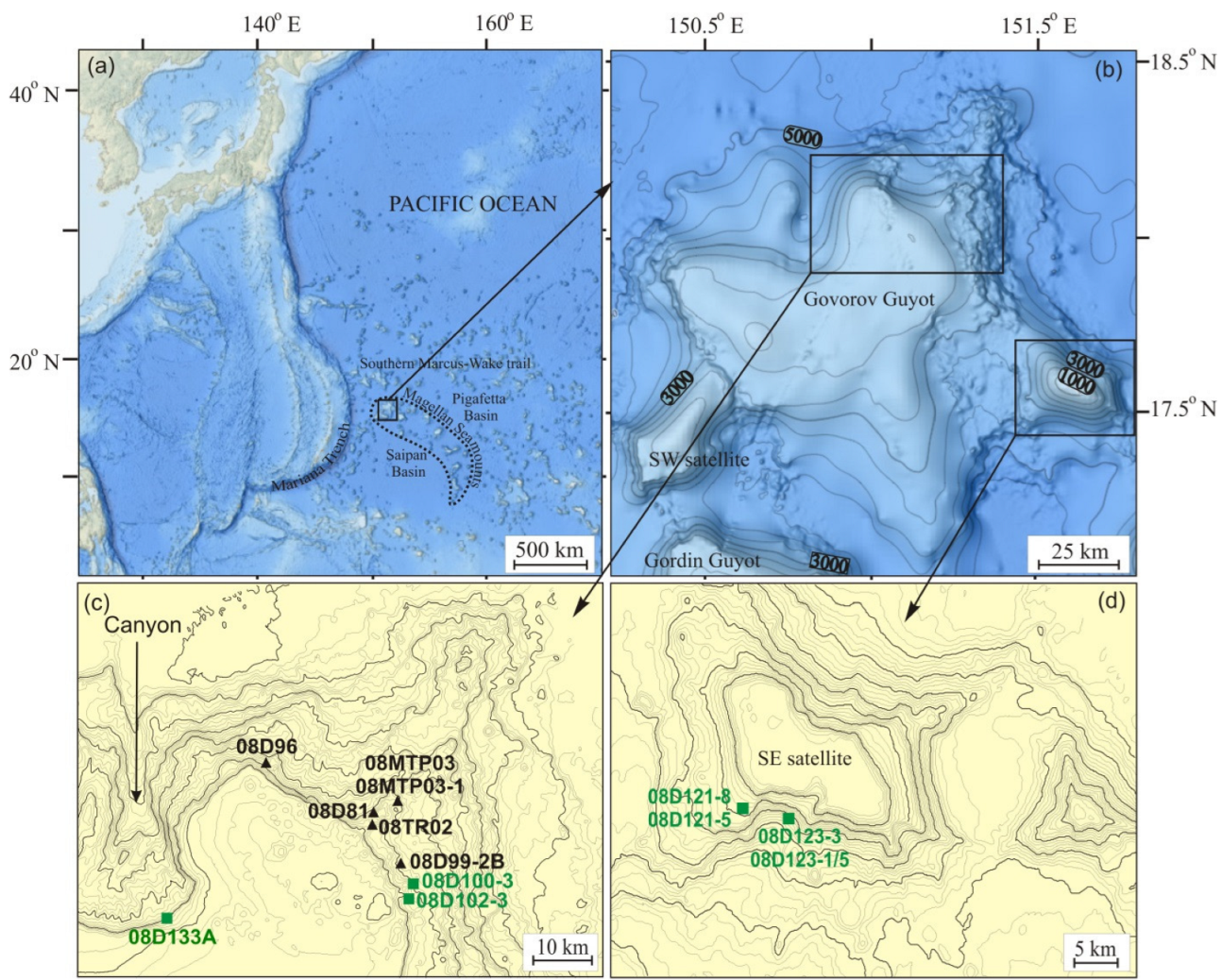
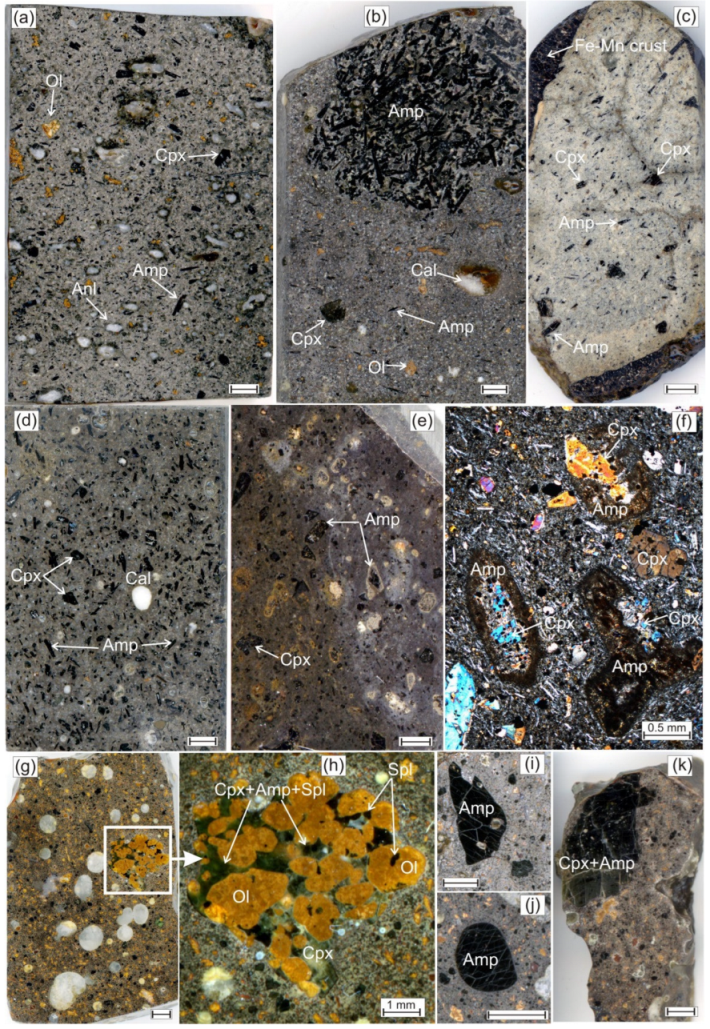
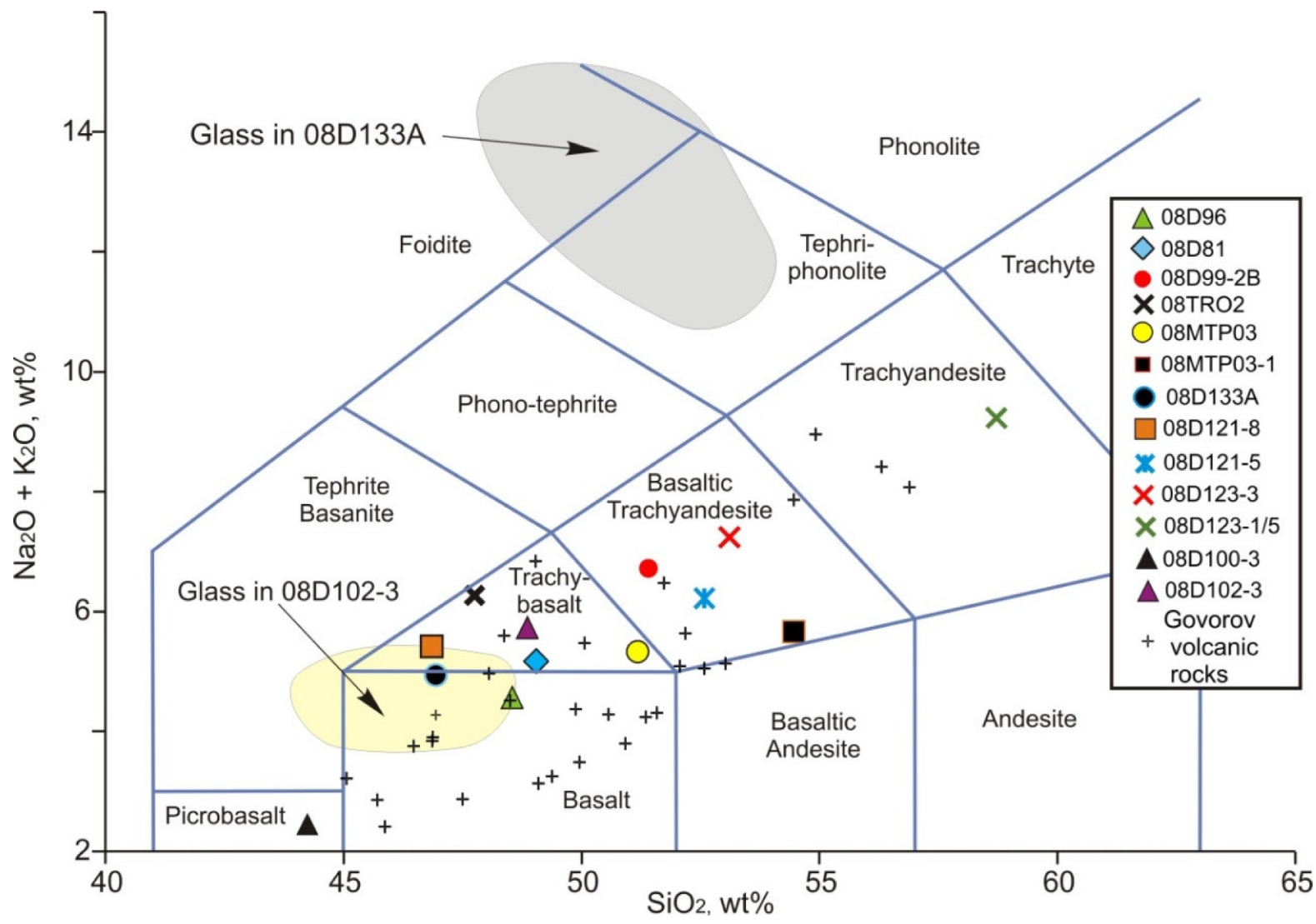
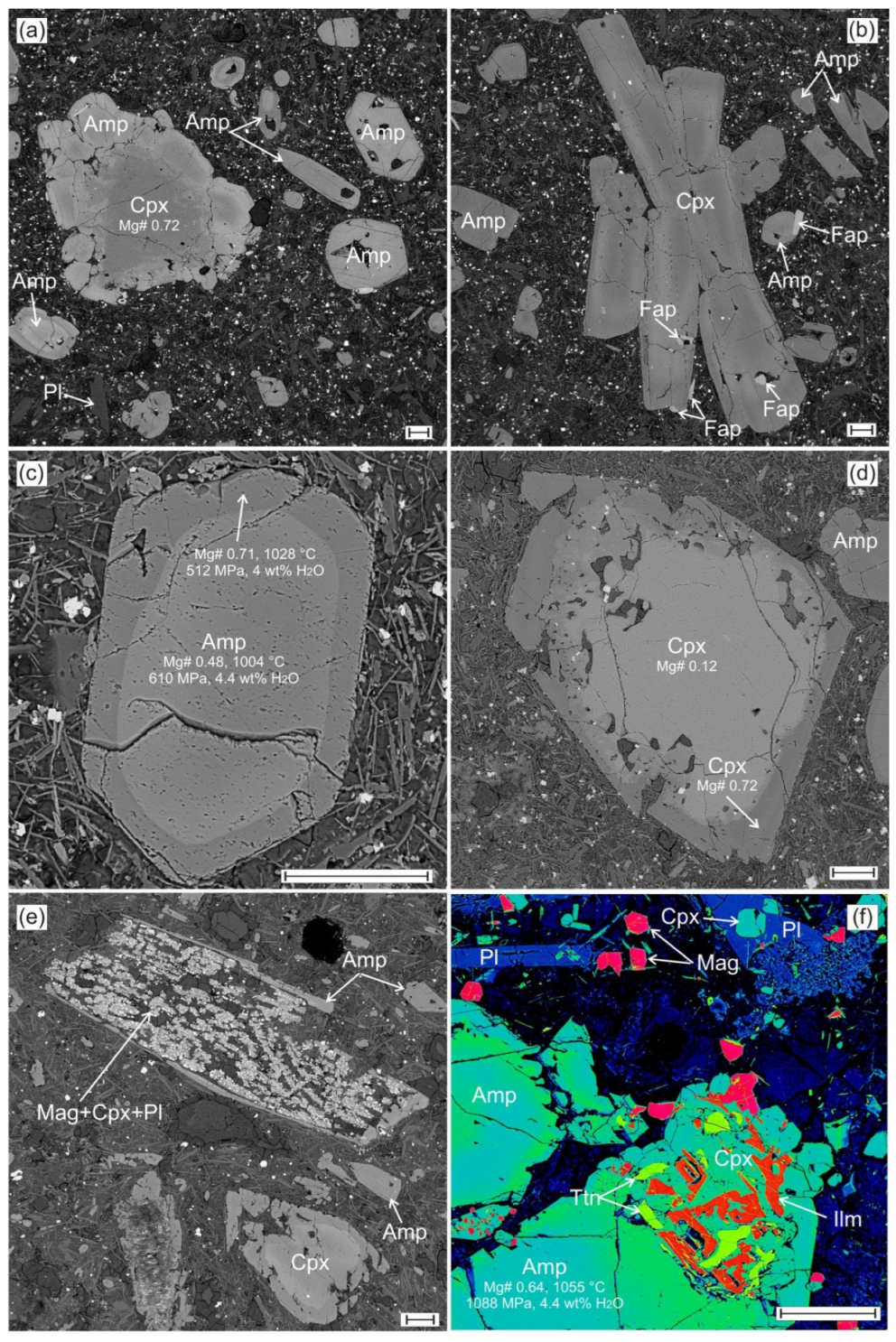
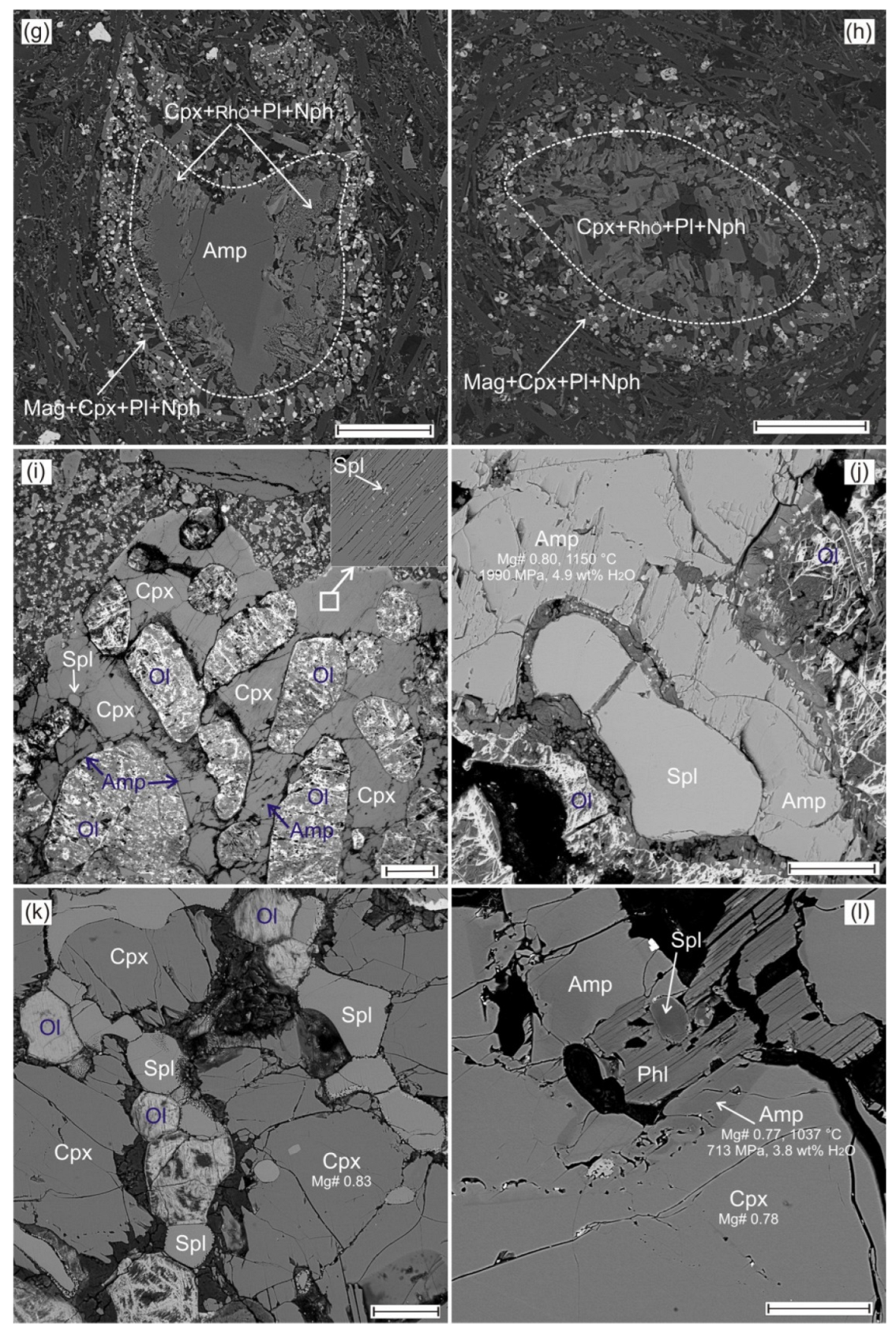
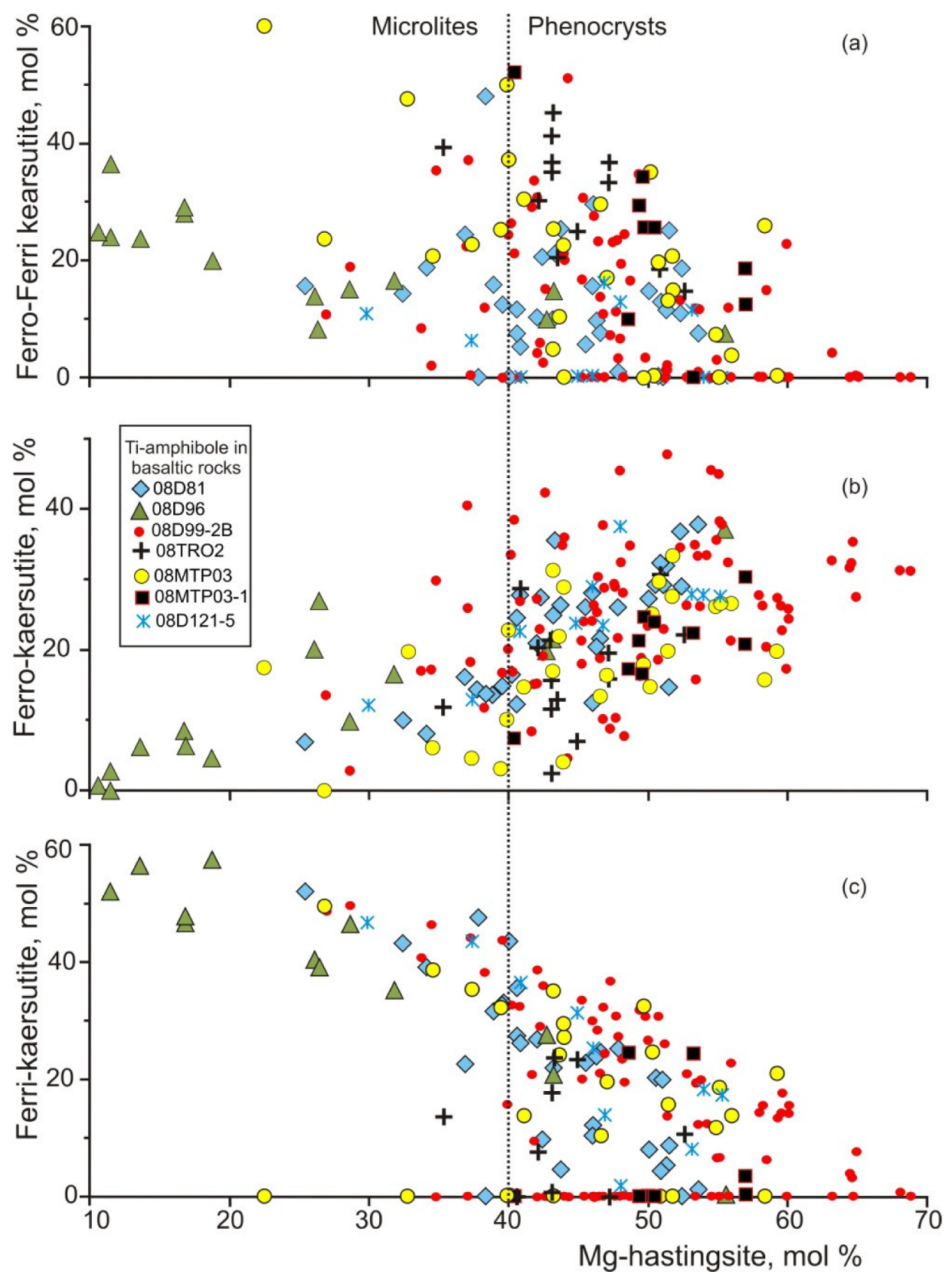

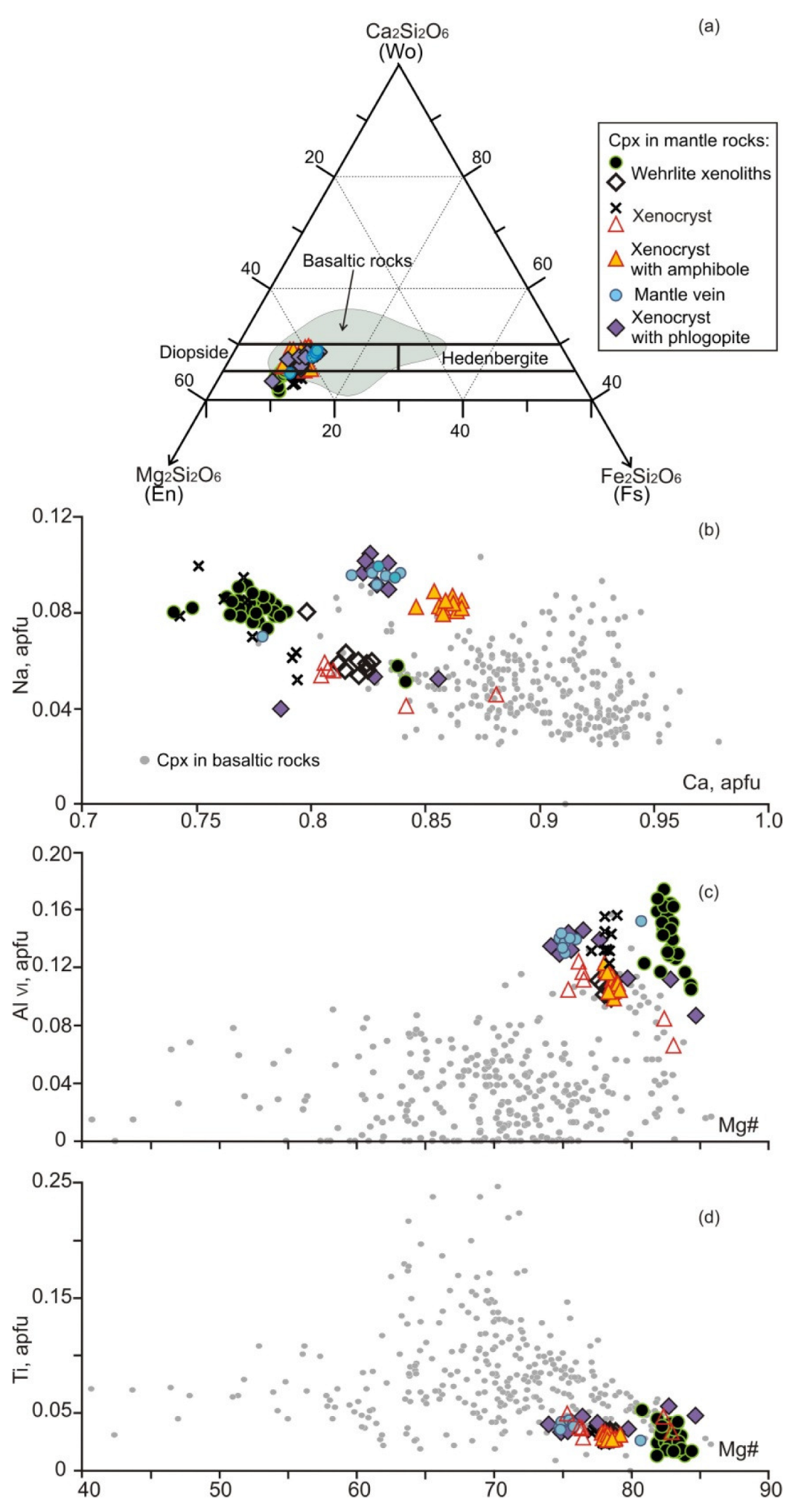




| Sample | 08D96 | 08D81 | 08D99-2B | 08TR02 | 08MTP03 | 08MTP03-1 | 08D121-5 | 08D100-3 | ||||||
|---|---|---|---|---|---|---|---|---|---|---|---|---|---|---|
| (15) | (32) | (85) | (13) | (28) | (9) | (10) | (14) | (4) | (6) | (14) | (11) | (15) | (4) | |
| Column Num. | 1 | 2 | 3 | 4 | 5 | 6 | 7 | 8 | 9 | 10 | 11 | 12 | 13 | 14 |
| SiO2 | 38.65 | 38.35 | 39.02 | 37.76 | 38.25 | 38.49 | 38.95 | 40.76 | 39.36 | 39.71 | 39.57 | 38.84 | 39.18 | 38.81 |
| TiO2 | 7.36 | 5.15 | 4.71 | 4.18 | 4.49 | 4.01 | 6.05 | 3.40 | 3.59 | 3.23 | 4.20 | 3.97 | 3.96 | 4.77 |
| Al2O3 | 12.29 | 13.32 | 12.86 | 12.94 | 12.90 | 12.56 | 12.41 | 15.15 | 15.21 | 14.12 | 14.54 | 14.32 | 14.50 | 13.46 |
| Cr2O3 | bd | bd | bd | bd | bd | bd | bd | 0.56 | 0.10 | 0.24 | 0.13 | bd | bd | bd |
| FeO tot | 14.87 | 14.48 | 13.99 | 17.73 | 15.42 | 16.36 | 12.46 | 6.93 | 8.33 | 8.96 | 9.74 | 10.42 | 11.44 | 7.77 |
| MnO | bd | 0.10 | 0.20 | 0.41 | 0.23 | 0.27 | bd | 0.05 | 0.06 | 0.14 | 0.12 | 0.09 | 0.09 | 0.07 |
| MgO | 10.49 | 10.62 | 11.01 | 8.74 | 10.17 | 9.78 | 11.98 | 15.05 | 13.59 | 13.42 | 12.81 | 12.38 | 12.16 | 14.68 |
| CaO | 11.47 | 12.11 | 11.62 | 12.07 | 11.84 | 11.90 | 12.14 | 10.70 | 10.45 | 11.31 | 11.05 | 10.97 | 11.17 | 11.53 |
| Na2O | 2.54 | 2.30 | 2.40 | 2.33 | 2.41 | 2.43 | 2.79 | 2.55 | 2.29 | 2.39 | 2.21 | 2.11 | 2.12 | 2.01 |
| K2O | 1.65 | 1.72 | 1.83 | 1.81 | 1.81 | 1.75 | 0.73 | 1.51 | 1.85 | 1.82 | 2.18 | 2.25 | 2.29 | 1.63 |
| Total | 99.63 | 98.14 | 97.64 | 97.96 | 97.51 | 97.53 | 97.50 | 96.66 | 94.89 | 95.35 | 96.58 | 95.36 | 96.90 | 94.73 |
| Corrected compositions calculated with AMFORM, Ridolfi et al. [25] | ||||||||||||||
| SiO2 | 38.38 | 38.50 | 39.34 | 37.89 | 38.59 | 38.78 | 39.40 | 41.46 | 40.75 | 40.87 | 40.33 | 40.04 | 39.77 | 40.30 |
| TiO2 | 7.31 | 5.17 | 4.75 | 4.20 | 4.53 | 4.04 | 6.12 | 3.46 | 3.72 | 3.33 | 4.28 | 4.09 | 4.02 | 4.95 |
| Al2O3 | 12.20 | 13.37 | 12.97 | 12.99 | 13.02 | 12.65 | 12.55 | 15.41 | 15.75 | 14.53 | 14.82 | 14.76 | 14.72 | 13.97 |
| Cr2O3 | 0.57 | 0.10 | 0.24 | 0.13 | ||||||||||
| FeO tot | 14.76 | 14.53 | 14.11 | 17.79 | 15.66 | 16.48 | 12.60 | 7.05 | 8.62 | 9.22 | 9.93 | 10.74 | 11.61 | 8.07 |
| Fe2O3 | 6.08 | 6.42 | 5.66 | 7.02 | 6.90 | 6.50 | 4.96 | 2.91 | 5.04 | 4.33 | 3.70 | 4.74 | 4.96 | 4.76 |
| FeO | 9.29 | 8.76 | 9.01 | 11.48 | 9.35 | 10.63 | 8.13 | 4.44 | 4.09 | 5.33 | 6.60 | 6.48 | 7.15 | 3.78 |
| MnO | 0.10 | 0.20 | 0.41 | 0.23 | 0.27 | 0.05 | 0.06 | 0.15 | 0.12 | 0.09 | 0.09 | 0.08 | ||
| MgO | 10.41 | 10.66 | 11.10 | 8.77 | 10.26 | 9.86 | 12.11 | 15.31 | 14.07 | 13.81 | 13.06 | 12.76 | 12.35 | 15.24 |
| CaO | 11.39 | 12.16 | 11.72 | 12.11 | 11.95 | 11.99 | 12.28 | 10.89 | 10.82 | 11.64 | 11.26 | 11.30 | 11.34 | 11.97 |
| Na2O | 2.52 | 2.31 | 2.42 | 2.34 | 2.43 | 2.45 | 2.83 | 2.60 | 2.37 | 2.46 | 2.25 | 2.17 | 2.15 | 2.08 |
| K2O | 1.64 | 1.72 | 1.85 | 1.82 | 1.83 | 1.76 | 0.74 | 1.54 | 1.92 | 1.88 | 2.23 | 2.32 | 2.33 | 1.70 |
| H2O | 0.84 | 1.09 | 1.20 | 1.30 | 1.23 | 1.32 | 1.03 | 1.33 | 1.25 | 1.41 | 1.19 | 1.20 | 1.21 | 1.10 |
| Total | 100.05 | 100.27 | 100.21 | 100.32 | 100.30 | 100.25 | 100.16 | 99.96 | 99.99 | 99.98 | 99.99 | 99.97 | 100.08 | 99.93 |
| Crystal chemical formulas, apfu | ||||||||||||||
| Si | 5.831 | 5.813 | 5.921 | 5.802 | 5.843 | 5.894 | 5.893 | 6.012 | 5.944 | 5.998 | 5.960 | 5.935 | 5.913 | 5.909 |
| Al IV | 2.169 | 2.187 | 2.079 | 2.198 | 2.157 | 2.106 | 2.107 | 1.988 | 2.056 | 2.002 | 2.040 | 2.065 | 2.087 | 2.091 |
| Ti | 0.836 | 0.587 | 0.538 | 0.484 | 0.515 | 0.462 | 0.689 | 0.377 | 0.408 | 0.367 | 0.475 | 0.456 | 0.449 | 0.546 |
| Al VI | 0.016 | 0.192 | 0.221 | 0.146 | 0.165 | 0.160 | 0.106 | 0.646 | 0.652 | 0.511 | 0.542 | 0.513 | 0.492 | 0.324 |
| Fe3+ | 0.696 | 0.729 | 0.641 | 0.809 | 0.786 | 0.743 | 0.559 | 0.317 | 0.553 | 0.478 | 0.411 | 0.528 | 0.555 | 0.525 |
| Fe2+ | 1.180 | 1.106 | 1.134 | 1.470 | 1.183 | 1.351 | 1.017 | 0.538 | 0.499 | 0.654 | 0.816 | 0.803 | 0.889 | 0.464 |
| Mg | 2.358 | 2.400 | 2.491 | 2.002 | 2.315 | 2.233 | 2.701 | 3.308 | 3.059 | 3.022 | 2.877 | 2.819 | 2.737 | 3.332 |
| Mn | 0.012 | 0.025 | 0.053 | 0.030 | 0.035 | 0.006 | 0.007 | 0.018 | 0.015 | 0.011 | 0.011 | 0.009 | ||
| Cr | 0.065 | 0.012 | 0.028 | 0.015 | ||||||||||
| Total | 13.085 | 13.026 | 13.051 | 12.963 | 12.995 | 12.985 | 13.072 | 13.258 | 13.191 | 13.078 | 13.153 | 13.130 | 13.133 | 13.202 |
| Ca | 1.854 | 1.966 | 1.889 | 1.987 | 1.938 | 1.952 | 1.968 | 1.692 | 1.691 | 1.830 | 1.783 | 1.795 | 1.806 | 1.881 |
| Na | 0.744 | 0.676 | 0.705 | 0.695 | 0.714 | 0.721 | 0.819 | 0.730 | 0.671 | 0.699 | 0.644 | 0.624 | 0.559 | 0.593 |
| K | 0.317 | 0.332 | 0.355 | 0.356 | 0.353 | 0.342 | 0.142 | 0.284 | 0.356 | 0.351 | 0.420 | 0.439 | 0.441 | 0.317 |
| OH | 0.847 | 1.101 | 1.201 | 1.326 | 1.241 | 1.342 | 1.026 | 1.291 | 1.215 | 1.378 | 1.175 | 1.191 | 1.202 | 1.074 |
| O | 1.153 | 0.899 | 0.799 | 0.674 | 0.759 | 0.658 | 0.974 | 0.709 | 0.768 | 0.617 | 0.816 | 0.802 | 0.798 | 0.926 |
| Mg# | 0.557 | 0.567 | 0.584 | 0.468 | 0.540 | 0.516 | 0.632 | 0.795 | 0.744 | 0.728 | 0.701 | 0.679 | 0.655 | 0.771 |
| End-members, mol% | ||||||||||||||
| Pargasite | 49.04 | 43.19 | 30.06 | 30.77 | 25.82 | 21.56 | 27.41 | |||||||
| Edenite | 2.76 | 0 | 1.30 | 0.66 | 0 | 0 | 3.57 | |||||||
| Mg-Hst | 25.28 | 43.82 | 49.05 | 44.39 | 45.19 | 50.59 | 45.63 | 15.85 | 14.80 | 32.88 | 24.71 | 30.52 | 35.45 | 22.87 |
| Fkrs | 42.58 | 20.34 | 15.30 | 7.40 | 16.19 | 5.85 | 24.25 | 17.28 | 25.06 | 14.34 | 19.49 | 18.15 | 14.51 | 35.15 |
| Fe2Krs | 12.8 | 22.38 | 25.84 | 16.88 | 18.33 | 20.48 | 24.38 | 15.06 | 16.95 | 21.43 | 24.37 | 25.51 | 28.48 | 11.00 |
| Fe3Fe2Krs | 19.29 | 13.46 | 9.81 | 31.33 | 20.29 | 23.08 | 5.74 | |||||||
| Thermobarometric-chemometric parameters | ||||||||||||||
| T, °C | 1084 | 978 | 1011 | 987 | 1001 | 966 | 1013 | 1149 | 1066 | 1069 | 1055 | 1018 | 1009 | 1037 |
| P, MPa | 540 | 493 | 899 | 725 | 918 | 436 | 396 | 1992 | 1677 | 1957 | 1459 | 1333 | 1260 | 713 |
| Depth, km | 19 | 18 | 31 | 25 | 32 | 16 | 14 | 62 | 54 | 61 | 48 | 44 | 42 | 25 |
| H2O, wt% | 2.66 | 5.25 | 4.23 | 4.94 | 4.68 | 5.14 | 4.70 | 4.87 | 5.30 | 5.53 | 4.68 | 5.15 | 5.36 | 3.82 |
Publisher’s Note: MDPI stays neutral with regard to jurisdictional claims in published maps and institutional affiliations. |
© 2022 by the authors. Licensee MDPI, Basel, Switzerland. This article is an open access article distributed under the terms and conditions of the Creative Commons Attribution (CC BY) license (https://creativecommons.org/licenses/by/4.0/).
Share and Cite
Peretyazhko, I.S.; Savina, E.A. Chemistry and Crystallization Conditions of Minerals in Metasomatized Oceanic Lithosphere and Basaltic Rocks of Govorov Guyot, Magellan Seamounts, Pacific Ocean. Minerals 2022, 12, 1305. https://doi.org/10.3390/min12101305
Peretyazhko IS, Savina EA. Chemistry and Crystallization Conditions of Minerals in Metasomatized Oceanic Lithosphere and Basaltic Rocks of Govorov Guyot, Magellan Seamounts, Pacific Ocean. Minerals. 2022; 12(10):1305. https://doi.org/10.3390/min12101305
Chicago/Turabian StylePeretyazhko, Igor S., and Elena A. Savina. 2022. "Chemistry and Crystallization Conditions of Minerals in Metasomatized Oceanic Lithosphere and Basaltic Rocks of Govorov Guyot, Magellan Seamounts, Pacific Ocean" Minerals 12, no. 10: 1305. https://doi.org/10.3390/min12101305
APA StylePeretyazhko, I. S., & Savina, E. A. (2022). Chemistry and Crystallization Conditions of Minerals in Metasomatized Oceanic Lithosphere and Basaltic Rocks of Govorov Guyot, Magellan Seamounts, Pacific Ocean. Minerals, 12(10), 1305. https://doi.org/10.3390/min12101305







